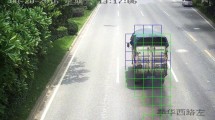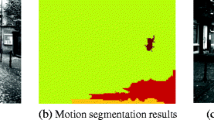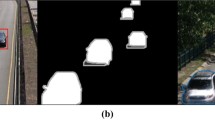Abstract
Existing smoky vehicle detection methods are vulnerable to false alarms because of the continuous interferences from common passed vehicles and the complex characteristics of smoke. This paper presents a video smoky vehicle detection method based on dynamic features. Three groups of features, including Multi-Sequence Integral Projection (MS-IP), Center-Symmetric Local Binary Patterns on Three Orthogonal Planes (CSLBP-TOP) and Histograms of Oriented Optical Flow (HOOF), are proposed or employed to characterize dynamic features of successive Region of Interest (ROIs). More specifically, the MS-IP characterizes the diffusion and distribution information based on multiple-sequence analysis and integral projection. The CSLBP-TOP characterizes the spatiotemporal texture information by (1) combining the strengths of Shift-Invariant Feature Transform (SIFT) and LBP and (2) extending the spatial features to three-dimensional (3D) space based on three orthogonal planes (TOP). The HOOF characterizes the motion information by inducing a very characteristic optical flow profile to distinguish smoky objects and non-smoky objects in successive ROIs based on the fact that the smoke is ejected from vehicle exhaust port and then gradually spreads around. The above three groups of features are complementary, and we fuse them to increase algorithm robustness. Experiment results show that our method achieves better performances than existing methods.











Similar content being viewed by others
Explore related subjects
Discover the latest articles, news and stories from top researchers in related subjects.References
Yan F, Winijkul E, Bond TC et al (2014) Global emission projections of particulate matter (PM): II. Uncertainty analyses of on-road vehicle exhaust emissions. Atmos Environ 87:189–199
Nagpure AS, Gurjar BR, Kumar V et al (2016) Estimation of exhaust and non-exhaust gaseous, particulate matter and air toxics emissions from on-road vehicles in Delhi. Atmos Environ 127:118–124
I. Asano, M. Shinohara, K. Hanada, Exhaust gas analysis system and exhaust gas analysis program, U.S. Patent 9 568 411 B2, Feb. 14, 2017
Pyykonen P, Peussa P, Kutila M et al (2016) Multi-camera-based smoke detection and traffic pollution analysis system. In: Proceedings of IEEE. ICCP, pp 233–238
Tao H, Lu X (2018) Smoky vehicle detection based on multi-scale block Tamura features, signal. Image Video Process 12(6):1061–1068
Tao H, Lu X (2018) Smoky vehicle detection based on multi-feature fusion and ensemble neural networks. Multimed Tools Appl 77(24):32153–32177
H. Tao, X. Lu (2018), Smoky vehicle detection in surveillance video based on gray level co-occurrence matrix. In: Proceedings of the International Conference on Digital Image Processing, China, p. 1080642
Tao H, Lu X (2018) Automatic smoky vehicle detection from traffic surveillance video based on vehicle rear detection and multi-feature fusion. IET Intell Transp Syst 13(2):252–259
Tao H, Lu X (2018) Contour-based smoky vehicle detection from surveillance video for alarm systems. SIViP 13(2):217–225
Tao H, Lu X (2018) Smoky vehicle detection based on range filtering on three orthogonal planes and motion orientation histogram. IEEE Access 6(1):57180–57190
Wang S, He Y, Yang H et al (2017) Video smoke detection using shape, color and dynamic features. J Intell Fuzzy Syst 33(1):305–313
Labati RD, Genovese A, Piuri V et al (2013) Wildfire smoke detection using computational intelligence techniques enhanced with synthetic smoke plume generation. IEEE Trans Syst Man Cybern Syst 43(4):1003–1012
Ko BC, Park JO, Nam JY (2013) Spatiotemporal bag-of-features for early wildfire smoke detection. Image Vis Comput 31(10):786–795
Gunay O, Toreyin BU, Kose K, Cetin AE (2012) Entropy-functional-based online adaptive decision fusion framework with application to wildfire detection in video. IEEE Trans Image Process 21(5):2853–2865
Tung TX, Kim JM (2011) An effective four-stage smoke-detection algorithm using video images for early fire-alarm systems. Fire Saf J 46(5):276–282
Calderara S, Piccinini P, Cucchiara R (2011) Vision based smoke detection system using image energy and color information. Mach Vision Appl 22(4):705–719
Chen J, He Y, Wang J (2010) Multi-feature fusion based fast video flame detection. Build Environ 45(5):1113–1122
Yuan F (2008) A fast accumulative motion orientation model based on integral image for video smoke detection. Pattern Recogn Lett 29(7):925–932
Ko BC, Cheong KH, Nam JY (2009) Fire detection based on vision sensor and support vector machines. Fire Saf J 44(3):322–329
Töreyin BU, Dedeoğlu Y, Güdükbay U et al (2006) Computer vision based method for real-time fire and flame detection. Pattern Recogn Lett 27(1):49–58
Yuan F, Shi J, Xia X et al (2016) High-order local ternary patterns with locality preserving projection for smoke detection and image classification. Inf Sci 372:225–240
Favorskaya M, Pyataeva A, Popov A (2015) Verification of smoke detection in video sequences based on Spatio-temporal local binary patterns. Procedia Comput Sci 60:671–680
Ye W, Zhao J, Wang S et al (2015) Dynamic texture based smoke detection using Surfacelet transform and HMT model. Fire Saf J 73:91–101
Yuan F (2012) A double mapping framework for extraction of shape-invariant features based on multi-scale partitions with AdaBoost for video smoke detection. Pattern Recogn 45(12):4326–4336
Tian H, Li W, Ogunbona P et al (2011) Smoke detection in videos using Non-Redundant Local Binary Pattern-based features. In: Proceedings of the International Workshop on Multimedia Signal Processing. IEEE, pp 1–4
Yuan F (2011) Video-based smoke detection with histogram sequence of LBP and LBPV pyramids. Fire Saf J 46(3):132–139
Hawkins JK (1970) Textural properties for pattern recognition. In: Lipkin B, Rosenfeld A (eds) Picture processing and psychopictorics. Academic Press, New York, pp 347–370
Tian H, Li W, Ogunbona P et al (2018) Detection and separation of smoke from single image frames. IEEE Trans Image Process 27(3):1164–1177
Tian H, Li W, Wang L et al (2014) Smoke detection in video: an image separation approach. Int J Comput Vis 106(2):192–209
Tian H, Li W, Wang L et al (2012) A novel video-based smoke detection method using image separation. In: Proceedings of IEEE International Conference on Multimedia and Expo, pp 532–537
Tian H, Li W, Ogunbona P et al (2014) Single image smoke detection. In: Proceedings of Asian conference on computer vision, pp 87–101
Yin Z, Wan B, Yuan F et al (2017) A deep normalization and convolutional neural network for image smoke detection. IEEE Access. 5(99):18429–18438
Luo Y, Zhao L, Liu P, Huang D (2018) Fire smoke detection algorithm based on motion characteristic and convolutional neural networks. Multimedia Tools Appl 77(12):15075–15092
Filonenko A, Kurnianggoro L, Jo KH (2017) Smoke detection on video sequences using convolutional and recurrent neural networks. Int Conf Comput Collect Intell Technol Appl:558–566
Shi L, Long F, Lin CH et al (2017) Video-based fire detection with saliency detection and convolutional neural networks. In: International symposium on neural networks. Springer, Cham, pp 299–309
Xu G, Zhang Y, Zhang Q et al (2017) Deep domain adaptation based video smoke detection using synthetic smoke images. Fire Saf J 93:53–59
Frizzi S, Kaabi R, Bouchouicha M et al (2016) Convolutional neural network for video fire and smoke detection. In: 42nd Annual Conference of the IEEE Industrial Electronics Society. IEEE, pp 877–882
Sivaraman S, Trivedi MM (2013) Looking at vehicles on the road: a survey of vision-based vehicle detection, tracking, and behavior analysis. IEEE Trans Intell Transp Syst 14(4):1773–1795
Barnich O, Van Droogenbroeck M (2011) ViBe: a universal background subtraction algorithm for video sequences. IEEE Trans Image Process 20(6):1709–1724
R.N. Bracewell., Two-Dimensional Imaging, Englewood Cliffs, NJ, Prentice Hall, 1995, pp. 505–537
Lin G, Zhang Y, Zhang Q et al (2017) Smoke detection in video sequences based on dynamic texture using volume local binary patterns. KSII Trans Internet Inform Syst 11(11):5522–5536
Heikkilä M, Pietikäinen M, Schmid C (2009) Description of interest regions with local binary patterns. Pattern Recogn 42(3):425–436
Chaudhry R, Ravichandran A, Hager G et al (2009) Histograms of oriented optical flow and binet-cauchy kernels on nonlinear dynamical systems for the recognition of human actions. IEEE Conf Comput Vis Pattern Recog:1932–1939
P.A. Flach, M. Kull (2015), Precision-recall-gain curves: PR analysis done right. In: Proceedings of the 28th International Conference on Neural Information Processing Systems (NIPS), pp 838–846
Tao H, Lu X (2019) Smoke vehicle detection based on multi-feature fusion and hidden Markov model. Journal of Real-Time Image Processing
Tao H, Lu X (2019) Smoke vehicle detection based on robust codebook model and robust volume local binary count patterns. Image and Vision Computing
Wei W, Song H, Li W et al (2017) Gradient-driven parking navigation using a continuous information potential field based on wireless sensor network. Inf Sci 408:100–114
Qi Y, Wei W (2011) Information potential fields navigation in wireless ad-hoc sensor networks. Sensors 11(5):4794–4807
Xu Q, Wei W, Wang L et al (2014) GI/Geom/1 queue based on communication model for mesh networks. Int J Commun Syst 27(11):3013–3029
Wei W, Yang XL, Shen PY et al (2012) Holes detection in anisotropic sensornets: topological methods. Int J Distrib Sensor Netw 8(10):135054. https://doi.org/10.1155/2012/135054
Qiang Y, Zhang J, Wei W (2013) A Bijection between lattice-valued filters and lattice-valued congruences in residuated lattices. Math Probl Eng 36(8):4218–4229. 2013
Yang XL, Zhou B, Wei W et al (2012) Combined energy minimization for image reconstruction from few views. Math Probl Eng 32
Funding
This study was funded by the National Natural Science Foundation of China (No.51775515), National Key Research and Development Program of China (No. 2017YFF0206501), the Postgraduate Research and Practice Innovation Program of Jiangsu Province (No. KYCX18_0101), the Scientific Research Foundation of Graduate School of Southeast University (No.YBPY1871), and the State Scholarship Fund from China Scholarship Council.
Author information
Authors and Affiliations
Corresponding author
Ethics declarations
Conflict of interest
All the authors did not have conflict of interest.
Ethical approval
This article does not contain any studies with human participants performed by any of the authors.
Additional information
Publisher’s note
Springer Nature remains neutral with regard to jurisdictional claims in published maps and institutional affiliations.
Rights and permissions
About this article
Cite this article
Tao, H. Detecting smoky vehicles from traffic surveillance videos based on dynamic features. Appl Intell 50, 1057–1072 (2020). https://doi.org/10.1007/s10489-019-01589-z
Published:
Issue Date:
DOI: https://doi.org/10.1007/s10489-019-01589-z




